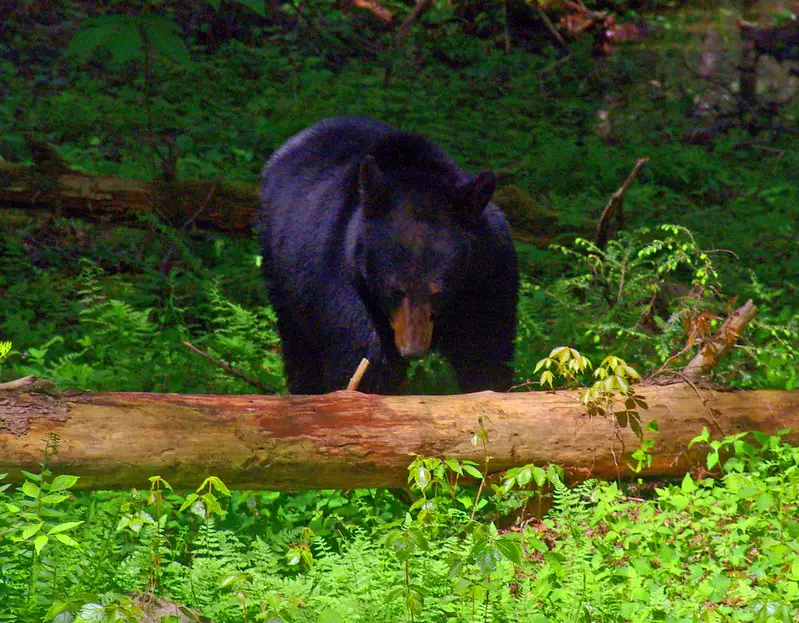Bears are fast, heavy animals, capable of taking lots of damage and escaping into the wild. Transporting a harvested bear requires great physical effort. Tracking a wounded bear is difficult. You must learn where to shoot a bear long before you start bear hunting. Knowing the best place to put your shot will eliminate the need for the former and significantly reduce the latter.

Where to shoot a bear for a quick recovery.
A wounded bear is a tremendous thing to behold, even from the relative safety of a tree stand. Watching hundreds of pounds of muscle blindly smashing and thrashing it way through the woods beneath you can be terrifying. You are torn between wanting it to waste its last moments within easy recovery range, and having the dreadful beast get as far away from you as possible.
The importance of shot placement when bear hunting.
Firstly, bear shot placement is an essential aspect of your safety when bear hunting. Wounded bears have injured or killed hunters, sometimes on purpose—or just by running them over while fleeing.
Secondly, you are unlikely to get a chance to take another shot. A fatally wounded bear with less than a minute to live can run hundreds of yards into the woods before dying, potentially adding hours of additional work to complete its harvesting. A badly wounded bear can take days to succumb to its injuries, leaving it to rot unrecovered.

The best place to shoot a bear is in the lungs.
The best place to shoot a bear is in the lungs with a shot that will pass through the entire chest cavity. With the bear facing broadside, wait for the leg facing to extend forward, then aim for a point in the middle of the body, behind the shoulder, and centered on the opposite leg.
There are three benefits to waiting for a taking this shot.
- The bear’s heart is exposed, meaning you could damage it and both lungs at the same time. This will lead to a “dead right there” (DRT) bear.
- Destruction of the lungs eliminates any chance of the bear escaping any significant distance away from you.
- As the shot passes through the bear’s chest cavity, it creates an entry and exit wound. Both wounds will make blood trailing the bear easier, even if you fail to damage the lungs.

Patience is critical for perfect bear shot placement.
Bear hunting is a waiting game, even with the bear in range. Bears are almost always moving and rarely present a perfect target. Amateur hunters hefting large caliber hunting rifles start to overestimate the power of their weapons. The combined effects of adrenaline, excitement and a lack of knowledge of bear anatomy often lead to a poorly timed shot.
Patience and self-discipline are the two most important weapons you’ll need when bear hunting. These personality traits are even more essential when bow hunting. A high-powered rifle may smash enough of a bear’s skeleton structure to anchor it to the ground, but the same shot with a bow will result in an unrecovered bear.

Aim to shoot a bear in the vitals, not the bones.
When you are bear hunting, penetration is your only goal. Aim to place your broadheads and bullets in the bear’s vital organs. Properly exposed (as in the broadside double lung shot), the vitals won’t keep your shot from creating an exit wound, either.
With penetration in mind, let’s consider the weapon you should use.
Bear hunting archers should avoid using mechanical/expanding tips. Firearm users will want to choose a round best described as offering ”controlled expansion and bone smashing penetration.”
Expansion isn’t exactly your enemy here, but if it comes too early or in the wrong place, it will ruin your hunt. An expandable broad-head that deploys upon striking a bear’s thick fur and muscle tissue will not have sufficient energy left to damage the vitals, let alone pass through the body.
Using the correct rifle round gives a firearm bear hunter more leeway than an archer. If the bullet accidentally impacts a bone, it might still punch through with enough force left over to destroy the vitals and exit the bear’s body. But this is true only on a broadside, double lung shot.
Related: How to hunt bears in the fall.

Where to shoot a bear: The quartering away shot.
The quartering away shot is the second-best bear hunting place to shoot a bear. By ”quartering away,” I mean slightly facing away from you. The angle here is critical. A shot at a bear quartering away from you too far can mean a hit in the hind quarters.
When taking a quartering away shot on a bear, wait until the near side leg is extended forward and aim to place your shot behind the shoulder, inline, and just forward of the opposite side leg and in the lower two-thirds of the chest cavity.

Again, the point of taking this shot is to achieve maximum damage to the vital organs, complete penetration, and entry and exit wounds to blood trail.
Related: What does bear poop look like?
Where to shoot a bear when in a tree stand.
Using a tree stand when bear hunting, especially when bow hunting, provides an extra level of safety to the hunter. There are fewer safer places to be, especially when a rampaging boar is tearing through the woods.
That safety comes at a cost, however. Hunting from a tree stand exposes to a fall hazard. Upwards of 4,000 hunters fall from tree stands every year. And shooting from an elevated location reduces the target size of the vital organs.
Bear hunting from a tree stand requires the use of fall protection for both of these reasons. Not only are you high up off the ground, but now you have to take a difficult shot that could require an awkward body position.
Make sure you erect your tree stand following the manufacturer’s instructions. Use your fall protection the entire time you are climbing into, out of, or sitting and standing in your stand.
Lastly, practice shooting from this location. This practice will help you determine the height to place your stand to get the best angle for maximum vital organ exposure.
Good bear shot placement guarantees recovery and reduces meat loss.
Bear hunting takes a lot of patience, but good shot placement should be your highest priority. The aiming points discussed above will produce clean, DRT kills. Taking these shots means waiting for the bear to get into the proper position and shooting only when the bear is within your effective range.
The broadside and quartering away shots are perfect for rifle and bow bear hunting. Each allows for maximum penetration, massive vital organ damage, and complete pass-through of the bear’s body. All while minimizing damage to the bear’s meat.

